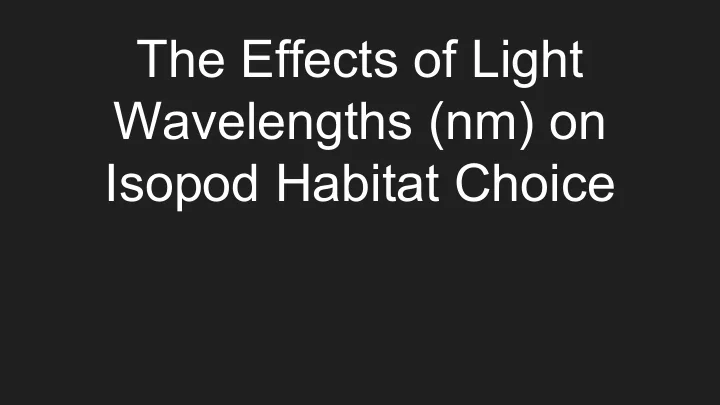

The Effects of Light Wavelengths (nm) on Isopod Habitat Choice
Background ❖ Isopods dwell in dark, moist environments ❖ As seen in lab, they’re found in leaf litter ❖ Of the crustacea class (terrestrial) → cannot survive in water ❖ They may also perform tonic immobility as a defence mechanism ➢ A state of reversible physical immobility or muscle hypertonicity (Quadros).
Week 1 Experiment Overview ❖ Green, Red, and Full-Spectrum Lights were set up over chambers (in lab room with fluorescent lights on) ❖ 5 new isopods were collected for each trial ❖ 2 minutes were provided for acclamation ❖ Opened gates and let them roam for 5 minutes ❖ Gates closed and isopod location was recorded
Week 1 Pictures
Week 2 Experiment Overview The experiment was conducted in a dark room to avoid outside light ❖ interference Green, Red, and Full-Spectrum Lights were set up over chambers in a dark ❖ room 5 new isopods were collected for each trial from the same environment ❖ 2 minutes were provided for acclamation ❖ Opened gates and let them roam for 5 minutes ❖ Gates closed and isopod location was recorded ❖
Week 2 Pictures
Constants ● The number of isopods in each trial ● The time for each trial ● Temperature - lamps used - 23.5 degrees F ● Distance between bulb and chamber = 6 in ● Distance between Light stand and chambers = 1 ⅜ in ● Bridge - no additional light ● All isopods are from the same environment
Data Table Full Spectrum Red Green 400-700 nm 571-687 nm 495-571 nm Mean 4.67 2 1 SD 1.32951 1.732051 0 * Data, graph, test,and conclusion from the second week only
Figure 1: The number of isopods found in each choice chamber after being exposed to different wavelengths (nm) of light. The bars represent the mean; error bars represent the standard deviation. For the 400-700 nm wavelength 4.67 nm +/- 1.32951 nm, for the 571-687 nm wavelength 2 nm +/- 1.732051 nm, and for the 495-571 nm (1) +/- 1 nm.
Full Spectrum P = 0.078927582 > .05 (400-700 nm) v. Red (571-687 nm) Full Spectrum (400-700 nm) P = 0.015268072 < .05 v. Green (495-571 nm) Full Spectrum P = 0.25 > .05 (400-700 nm) v. Full Spectrum (400-700 nm) Red P = 0.422649731 > .05 (571-687 nm) v. Green *T test was (495-571 nm) used
Conclusions and Future Recommendations Indifferent to the red light ➢ Did not tend to gather under the green light when paired with the full spectrum light. ➢ Future Recommendations ➢ *Add damp leaf litter to see if wavelength still affects isopods’ habitat choice Try blue light instead of red ➢ Possible Sources of Errors Doing experiment with other light besides the ones used directly over the chambers ➢ The temperature of the dark room (68 degrees fahrenheit) ➢
*Light Bulbs used
Recommend
More recommend